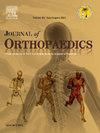解剖全肩关节置换术在生命的第七个十年表现出优于老年患者的长期维持性。
IF 1.5
Q3 ORTHOPEDICS
引用次数: 0
摘要
背景:解剖型全肩关节置换术(aTSA)常常被推迟,因为人们担心年轻、好动的患者术后功能改善的速度会更快。这项回顾性研究调查了患者年龄对肩关节置换术后至少 10 年的活动特异性功能结果的影响:方法:对肩关节置换术数据库进行回顾性研究。方法:对肩关节置换术数据库进行了回顾性审查:方法: 对肩关节置换术数据库进行了回顾性审查,共分为两组:60-70 岁接受肩关节置换术的患者和 70 岁以上至少随访 10 年的患者。主要结果包括活动范围(ROM)和患者报告结果(PROs),包括美国肩肘外科医生(ASES)、简单肩关节测试(SST)和视觉模拟量表(VAS)评分。此外,还对 ASES 评分问卷的个人调查回复进行了分析:共纳入 46 个肩关节,其中 60-70 岁年龄组 30 个,70 岁以上年龄组 16 个,平均年龄分别为 65.5 ± 3.0 岁和 74.2 ± 3.2 岁。60-70 岁组距手术时间为 15.6 ± 3.9 年,70 岁以上组距手术时间为 13.1 ± 3.2 年。术后,60-70 岁人群与 70 岁以上人群的评分分别为141.7°对153.1°前倾(p = 0.12)、52.4°对51.3°外旋(p = 0.82)、L1对T11内旋(p = 0.12)、2.1对2.1 VAS(p = 0.94)、75.7对73.8 ASES(p = 0.79)和7.8对8.8 SST(p = 0.35)。两组患者的术后评分相似。术前对 ASES 评分问卷中列出的任何活动的反应均无差异。然而,年轻患者在所有调查中的反应都有所改善,而 70 岁以上的患者在 10 项活动中仅有 5 项得到长期改善:结论:较早接受手术的患者与较早接受停经前列腺切除术的患者一样,都能获得长期持续的改善。结论:较早接受手术的患者可获得长期持续的功能和活动改善,这一点与较早接受手术的患者相同:3.本文章由计算机程序翻译,如有差异,请以英文原文为准。
Anatomic total shoulder arthroplasty in the 7th decade of life demonstrates superior long-term maintenance than in older patients
Background
Anatomic total shoulder arthroplasty (aTSA) is often delayed due to concerns about a more rapid loss of postoperative improvements in younger, more active patients. This retrospective study investigated the effects of patient age on activity-specific functional outcomes at a minimum of 10 years following aTSA.
Methods
A retrospective review of a shoulder arthroplasty database was performed. There were two cohorts: Patients who underwent aTSA at 60–70 years of age and patients 70+ years old with Minimum 10 years follow-up. Primary outcomes included range of motion (ROM) and patient reported outcomes (PROs) including American Shoulder and Elbow Surgeons (ASES), Simple Shoulder Test (SST), and Visual Analogue Scale (VAS) scores. Furthermore, individual survey responses to the ASES Score questionnaire were analyzed.
Results
46 shoulders, 30 shoulders in the 60–70 age cohort and 16 in the 70+ cohort, were included with a mean age of 65.5 ± 3.0 years and 74.2 ± 3.2 years, respectively. Interval from surgery was 15.6 ± 3.9 years in the 60–70 cohort, and 13.1 ± 3.2 years in the 70+ cohort. Postoperatively, scores for the 60–70 cohort versus 70+ respectively included: 141.7° versus 153.1° forward elevation (p = 0.12), 52.4° versus 51.3° external rotation (p = 0.82), L1 versus T11 internal rotation (p = 0.12), 2.1 versus 2.1 VAS (p = 0.94), 75.7 versus 73.8 ASES (p = 0.79), and 7.8 versus 8.8 SST (p = 0.35). Postoperative scores were similar between cohorts. No difference was seen in preoperative responses for any activity listed in the ASES-score questionnaire. However, younger patients showed improvement across all survey responses, while patients above age 70 had long-term improvement in only 5 of 10 activities.
Conclusion
Patients who receive surgery earlier may experience sustained improvement long-term, same as those who undergo aTSA at an older age. Patients undergoing aTSA earlier in life benefit from sustained long-term function and activity.
Level of evidence
3.
求助全文
通过发布文献求助,成功后即可免费获取论文全文。
去求助
来源期刊

Journal of orthopaedics
ORTHOPEDICS-
CiteScore
3.50
自引率
6.70%
发文量
202
审稿时长
56 days
期刊介绍:
Journal of Orthopaedics aims to be a leading journal in orthopaedics and contribute towards the improvement of quality of orthopedic health care. The journal publishes original research work and review articles related to different aspects of orthopaedics including Arthroplasty, Arthroscopy, Sports Medicine, Trauma, Spine and Spinal deformities, Pediatric orthopaedics, limb reconstruction procedures, hand surgery, and orthopaedic oncology. It also publishes articles on continuing education, health-related information, case reports and letters to the editor. It is requested to note that the journal has an international readership and all submissions should be aimed at specifying something about the setting in which the work was conducted. Authors must also provide any specific reasons for the research and also provide an elaborate description of the results.
 求助内容:
求助内容: 应助结果提醒方式:
应助结果提醒方式:


